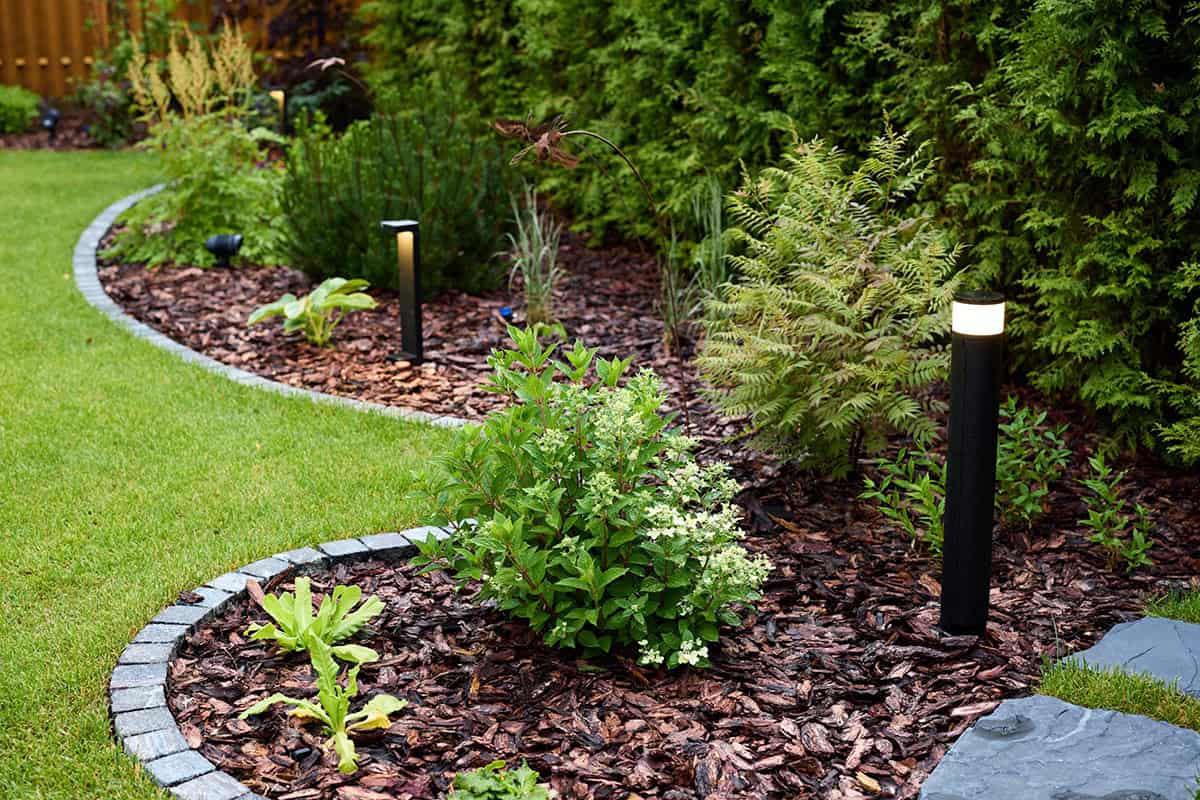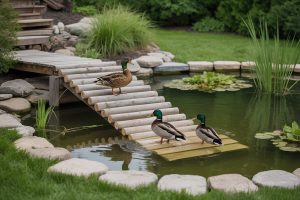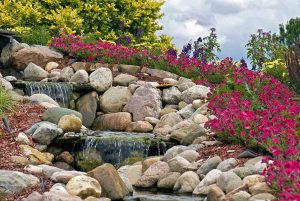You notice weeds creeping in and your garden edging falling apart, but hiring a landscaper isn’t in the budget. The good news is that small changes can make a big difference. These 30 cheap landscaping fixes are simple, effective, and perfect for anyone ready to spruce up their yard on a budget.
Table of Contents
- Cheap Landscaping Fixes
- Gravel Path With Border Stones
- Mulched Flower Bed With Annuals
- DIY Tire Planters Painted Bright Colors
- Cinder Block Raised Bed Garden
- Wood Pallet Vertical Garden On Fence
- Rock Garden With Succulents
- Solar Lights Lining A Driveway
- Reclaimed Brick Garden Border
- Recycled Tin Can Herb Garden
- DIY Tree Ring With Stones
- Stepping Stones Set In Grass
- Hose Storage Made From A Wooden Crate
- Painted Terra Cotta Pot Tower
- Fence-Mounted Hanging Baskets
- DIY Wood Chip Pathway
- Garden Bed With Cardboard Sheet Mulch
- Reclaimed Wood Garden Sign
- Vintage Chair Planter
- Plastic Kiddie Pool Garden Bed
- Painted Stones As Garden Markers
- Simple DIY Trellis With Bamboo Or Sticks
- Reused Wine Bottles As Edging
- DIY Fire Pit With Concrete Blocks
- Hanging Mason Jar Lanterns
- PVC Pipe Garden Tool Holder
- Thrifted Bench In Garden Nook
- DIY Compost Bin From Pallets
- Old Wheelbarrow Planter
- Rope-Wrapped Planter From Bucket
- Rain Gutter Planter Wall
Cheap Landscaping Fixes
With a handful of affordable upgrades, you can quickly make your yard look better. Everyday materials and a bit of elbow grease can turn a plain space into something you’re actually proud of—think gardens, walkways, or little corners to hang out in.
Gravel Path With Border Stones

Making a gravel path isn’t rocket science. You’ll need gravel, border stones, and some landscape fabric. Map out your path with string or even a hose. Cut away the grass along your route, then lay down fabric to keep weeds from popping through.
Spread your gravel over the top and smooth it out. Edge the path with stones to keep everything in place. Not only does this look tidy, but it also helps with drainage—no more muddy shoes after rain.
Mulched Flower Bed With Annuals
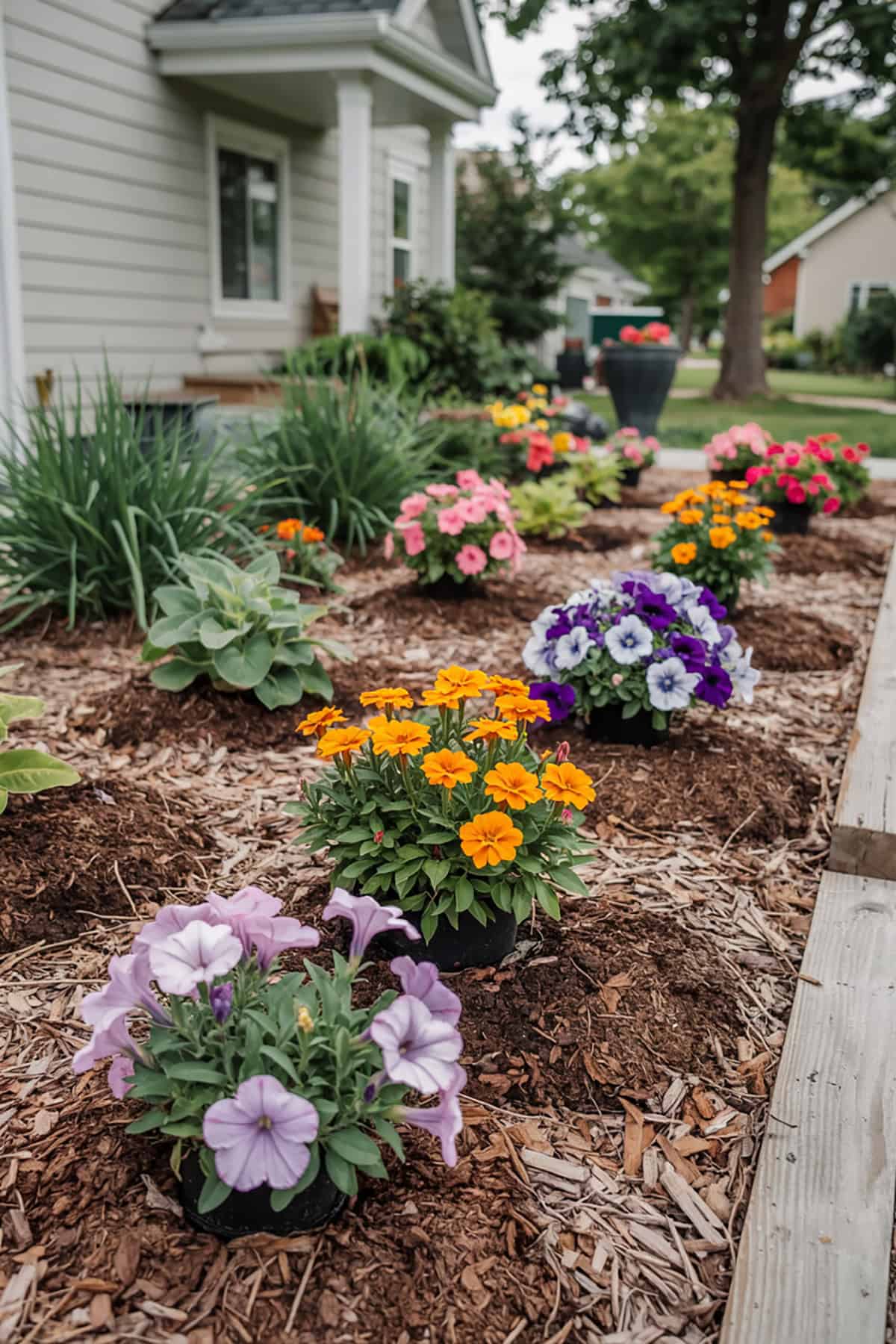
A quick flower bed can really wake up your curb appeal. Pick a spot near your entry or sidewalk, clear out the weeds, and plant some annuals.
Top it off with a thick mulch layer—wood chips, pine straw, or just shredded leaves from your yard all work. Mulch keeps things neat, holds moisture, and blocks weeds. It’s a cheap fix with a lot of visual payoff.
DIY Tire Planters Painted Bright Colors
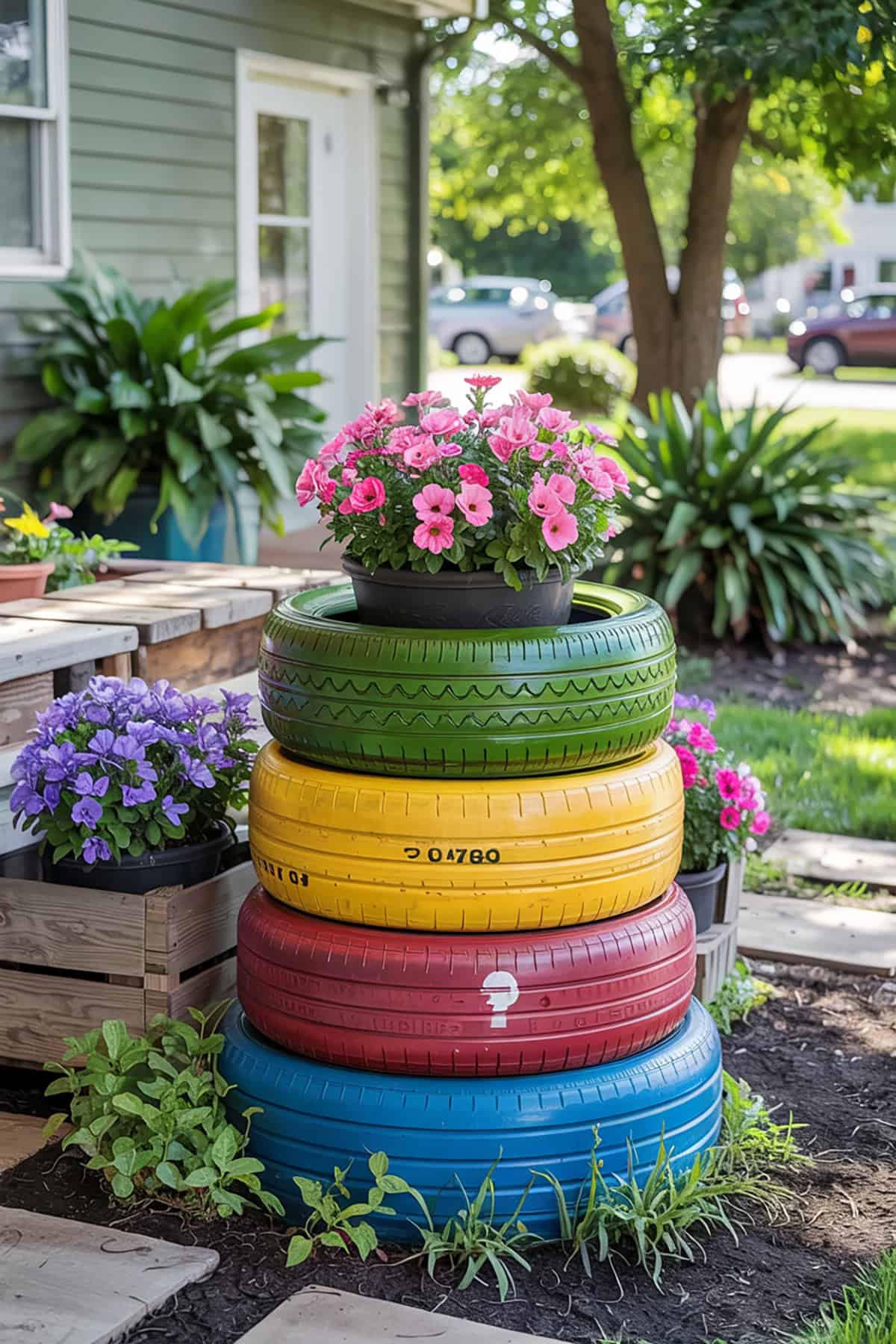
Got old tires? Don’t toss them—turn them into planters. Stack or lay them out wherever you want a splash of color. Give them a good scrub and hit them with some bold outdoor paint—yellow, blue, red, whatever makes you smile.
If you’re stacking, cut a few drainage holes. Fill with soil and flowers. These planters last for ages and keep tires out of the landfill, so that’s a win-win.
Cinder Block Raised Bed Garden

Cinder blocks make raised beds a breeze—no carpentry needed. Just line them up to form your bed, two blocks high if you want deeper soil. Make sure the ground’s level first.
You can plant right in the block holes, too—herbs, flowers, whatever fits. They warm up fast in spring and don’t rot. Plus, blocks are cheap and easy to find.
Wood Pallet Vertical Garden On Fence
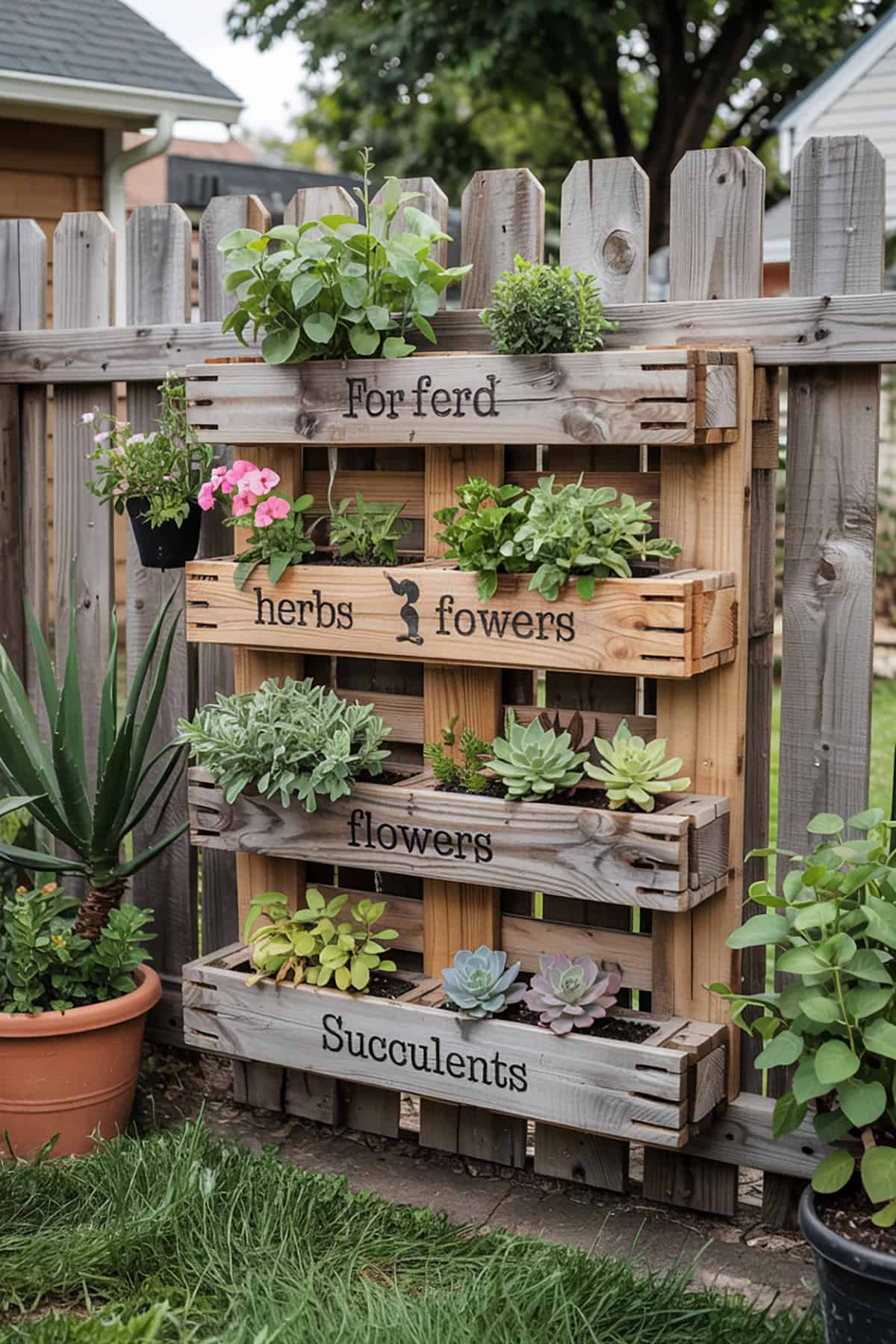
Short on space? Grab a wood pallet and attach it to your fence. Slip pots of herbs or flowers into the slats, or staple in fabric to make planting pockets.
Use zip ties or hooks to keep it steady, especially if your yard gets gusty. Pallets are usually free if you ask around at stores or warehouses, and they’re perfect for small yards.
Rock Garden With Succulents
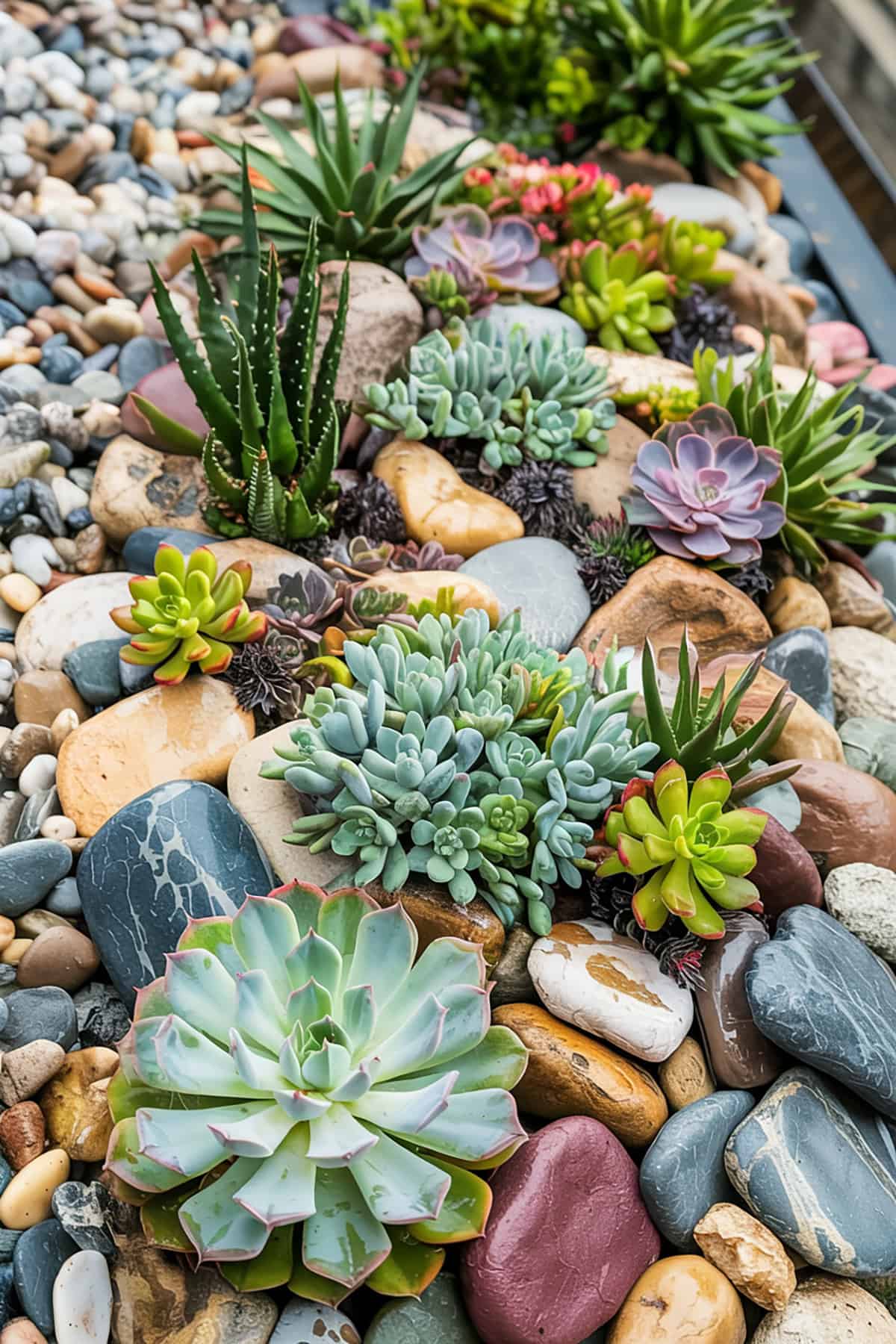
If you’ve got dry or rocky spots, don’t fight them—work with them. Gather up rocks and arrange them in a corner or by the driveway, then tuck hardy succulents between the stones.
Succulents barely need water and don’t mind poor soil. Arrange the rocks in a way that looks natural, and you’ve got a low-maintenance spot that costs next to nothing if you collect the rocks yourself.
Solar Lights Lining A Driveway
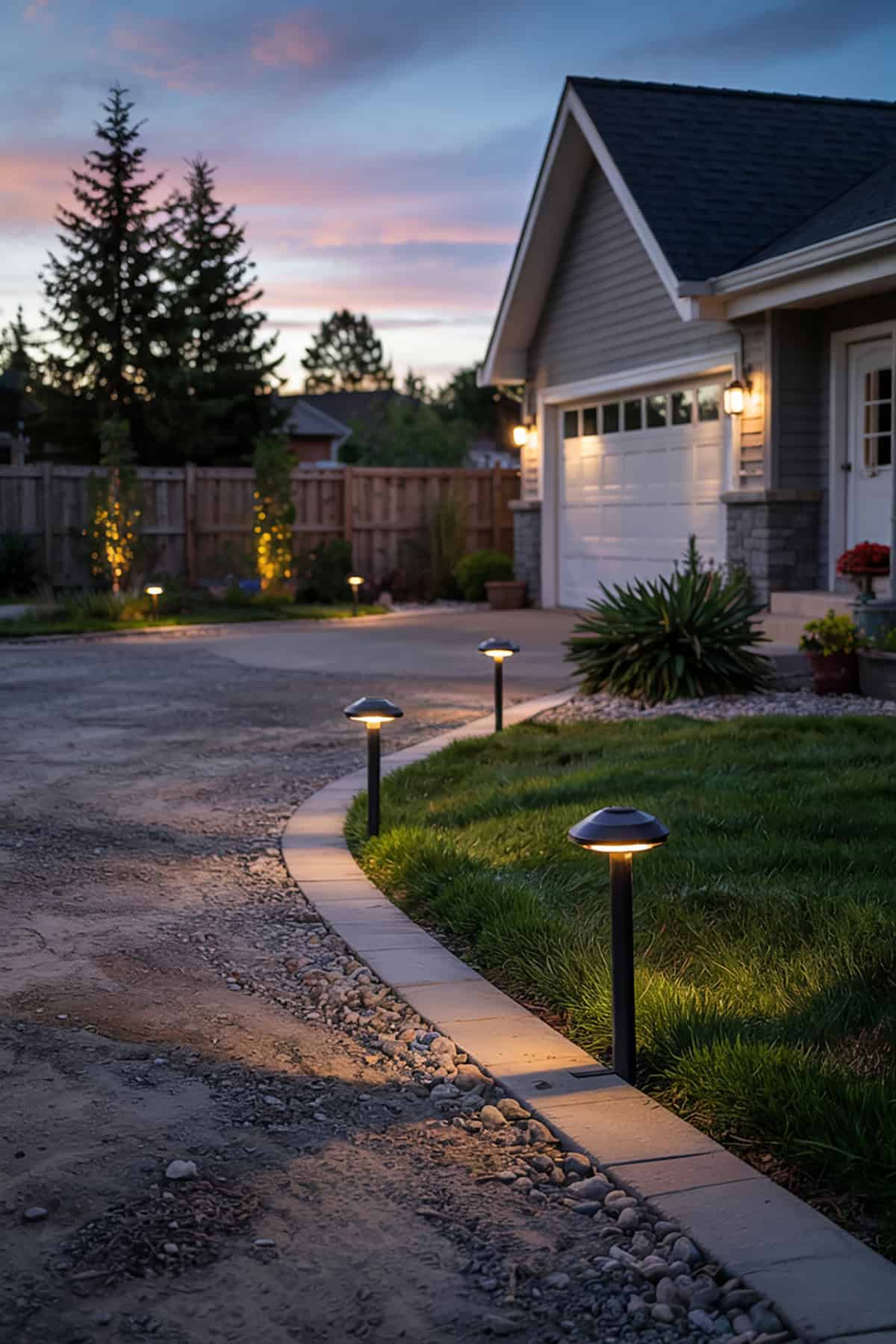
Driveways and paths look better (and are safer) with solar stake lights. Just pick up a few from the hardware store and space them along the edge of your walk or drive.
No wiring, no extra bills—they flip on at dusk by themselves. There’s plenty of styles out there, and installation takes just a few minutes. It’s a small touch, but it really makes your yard pop at night.
Reclaimed Brick Garden Border

If you come across old bricks—maybe leftovers from a project or a demolition—use them for garden edging. Lay them end-to-end along beds or paths, pressing them into the soil so they stay put.
Try straight, zigzag, or stacked patterns for different looks. If you’re lucky, you can get bricks for free, and they make a tidy, classic border.
Recycled Tin Can Herb Garden

Don’t toss those empty cans—turn them into mini herb gardens. Clean them out, punch a few drainage holes, and paint or label them if you’re feeling crafty. Fill with potting soil and your favorite herbs.
Set them on a patio, windowsill, or even hang them from a porch rail. They’re easy to move for sunlight and keep herbs handy for cooking.
DIY Tree Ring With Stones
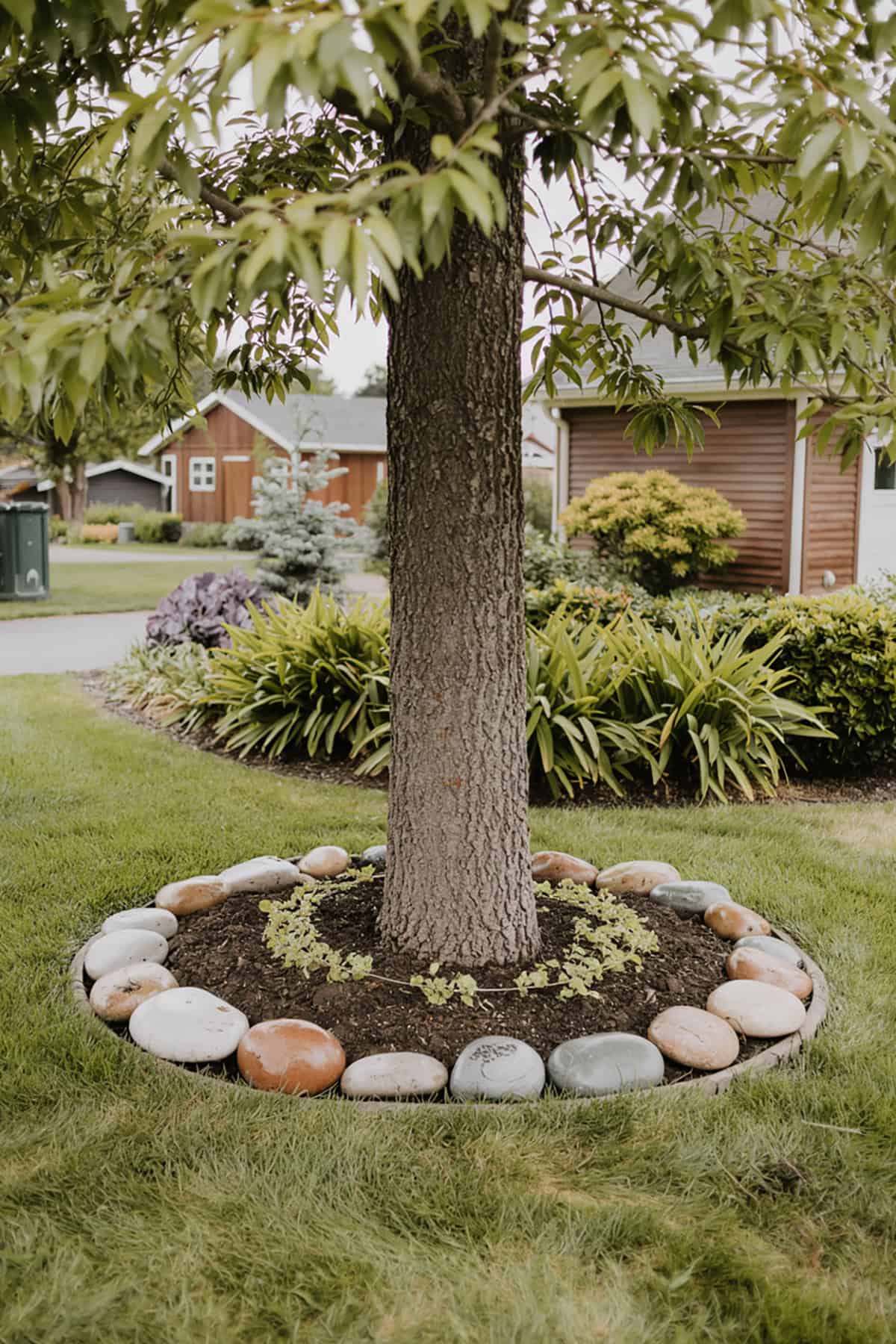
Tree bases can get messy fast. Gather rocks from your yard or buy a few small stones. Arrange them in a ring, a foot out from the trunk, two or three rows wide.
Fill the inside with mulch to block weeds and keep moisture in. The ring protects roots from the mower and makes everything look intentional, not overgrown.
Stepping Stones Set In Grass
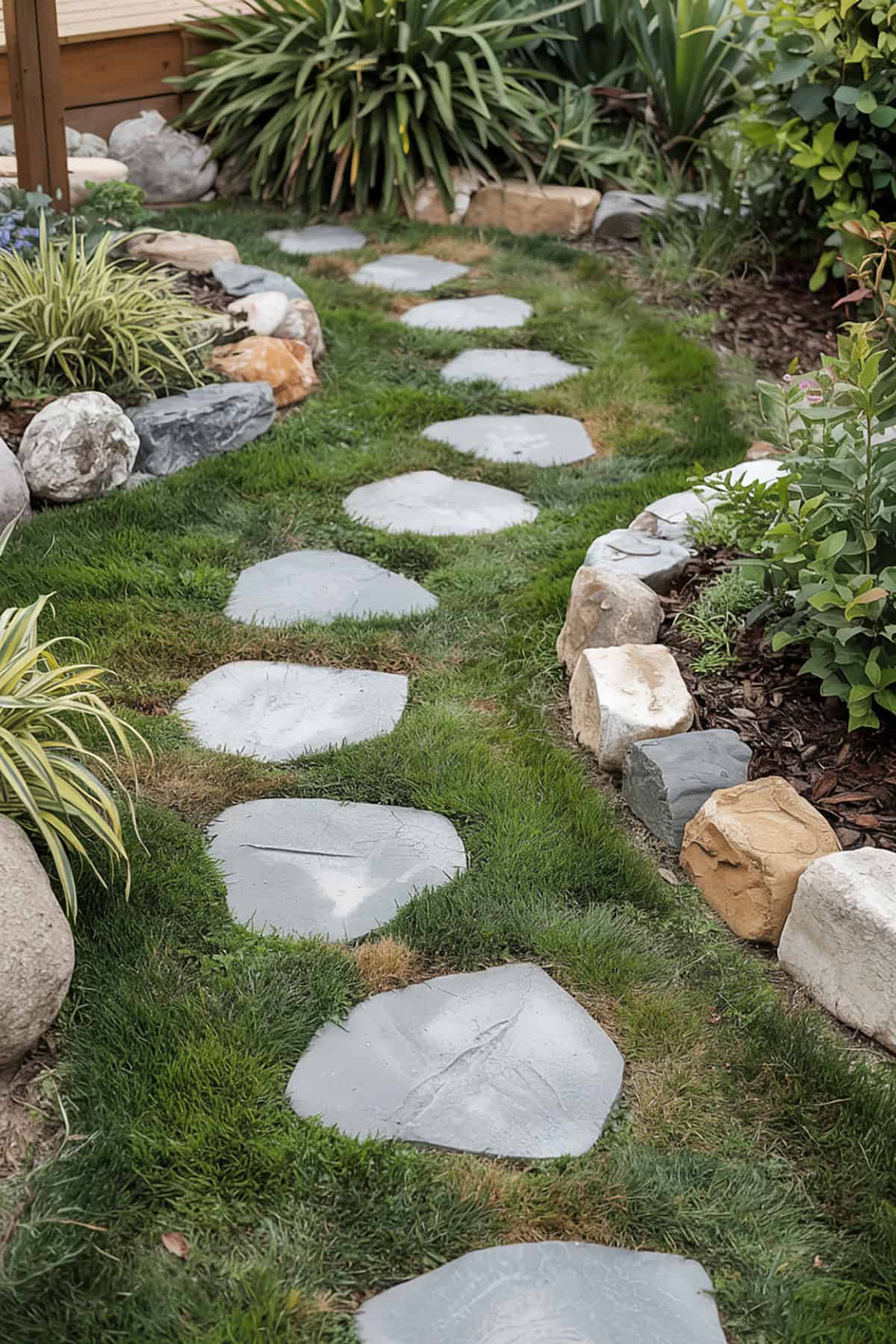
Stepping stones help you cross the lawn without turning it into a muddy mess. Buy flat stones or make your own with concrete molds. Set them a foot apart, in a line or curve.
Dig each one in so it’s flush with the grass. They blend right in but make a clear path, so no more worn-out patches or muddy shoes.
Hose Storage Made From A Wooden Crate
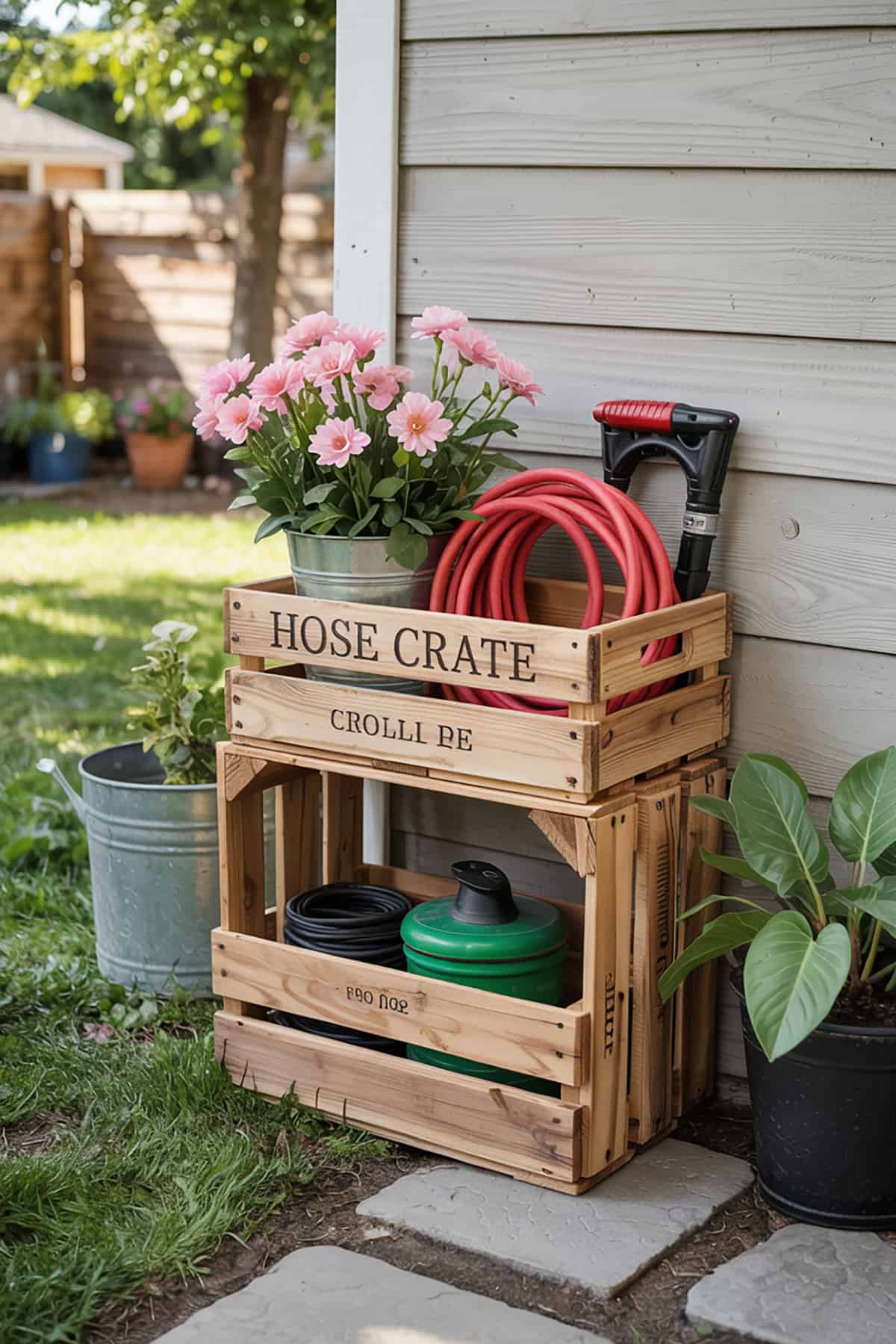
Garden hoses tend to sprawl everywhere. Mount a wood crate to your wall or fence near the spigot. Drill a few holes for drainage if you need to.
Coil the hose inside when you’re done. You can paint the crate to match your style, and it’s a whole lot better than tripping over hoses in the grass. Thrift stores usually have crates for cheap.
Painted Terra Cotta Pot Tower
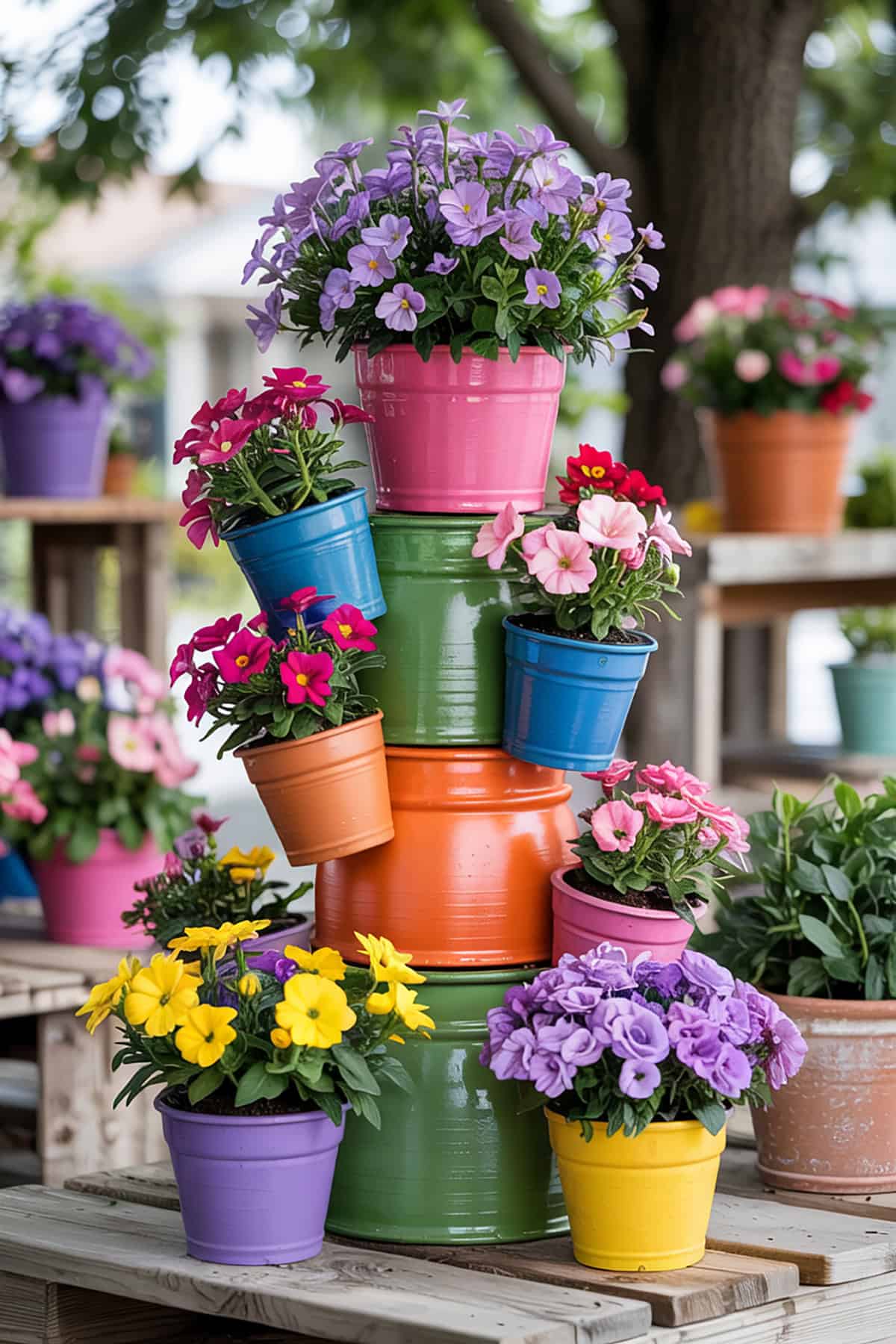
Stacking up terra cotta pots is a fun way to use up extra space. Paint each pot with weatherproof colors or patterns, then thread a metal rod through the drain holes to keep everything steady.
Plant annuals, vines, or succulents in each pot, tilting them slightly for a spiral effect. Set the tower by your porch or walkway—it’s a real eye-catcher, and you can change up the plants whenever you want.
Fence-Mounted Hanging Baskets

Plain fences are kind of boring. Attach hooks or brackets and hang flower baskets at eye level. Fill them with colorful annuals or trailing plants.
Metal or plastic baskets with liners hold up best. Just remember to water more often—baskets dry out fast when it’s hot. They’re perfect for renters or anyone with a small yard.
DIY Wood Chip Pathway
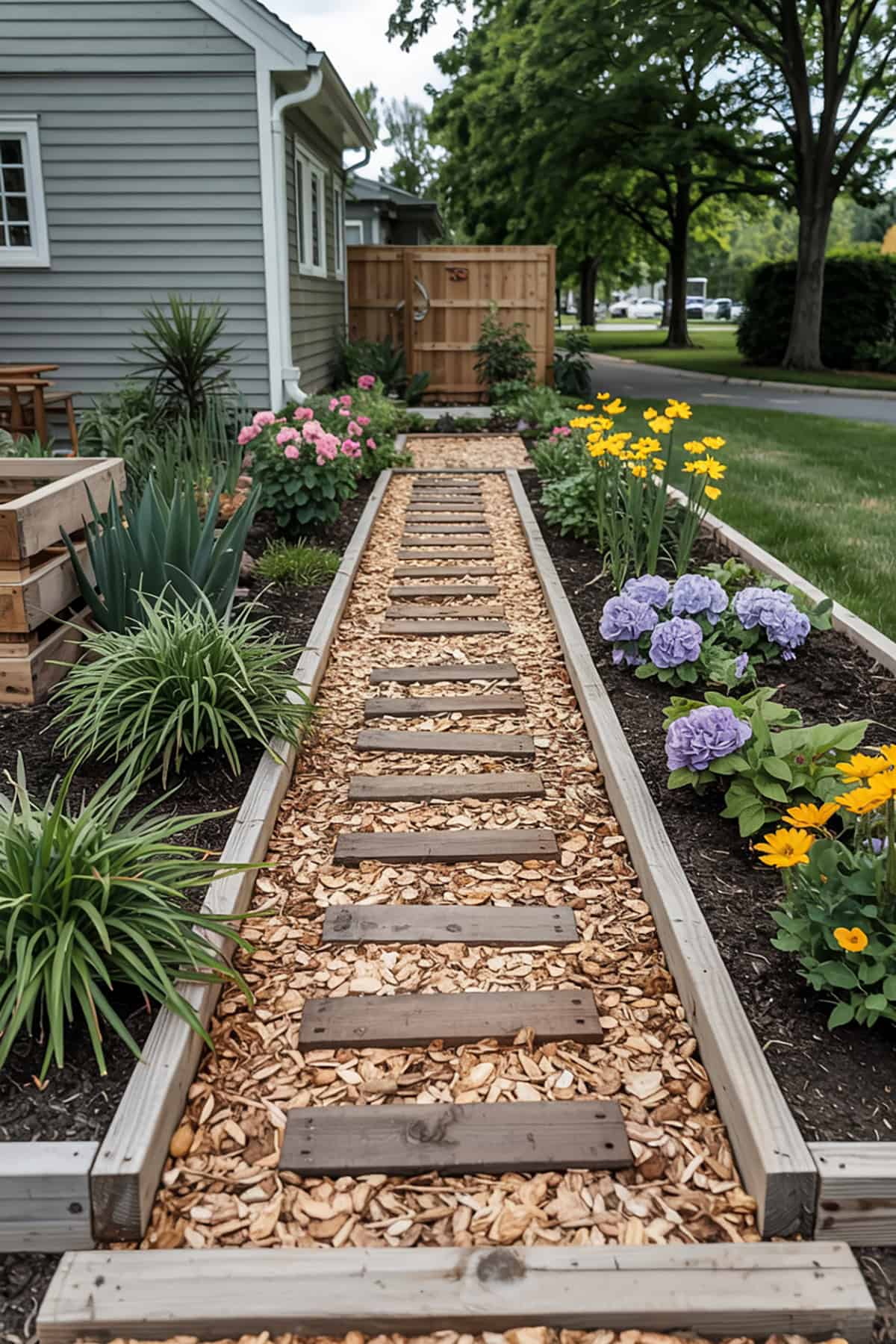
Wood chips make a comfy, natural-looking path. Outline your route with rope or stakes, strip away the grass, and lay down landscape fabric to block weeds.
Spread wood chips on top, raking them out evenly. Add extra where people walk most. Wood chips break down over time and actually help your soil, plus you can often snag them free from tree services.
Garden Bed With Cardboard Sheet Mulch
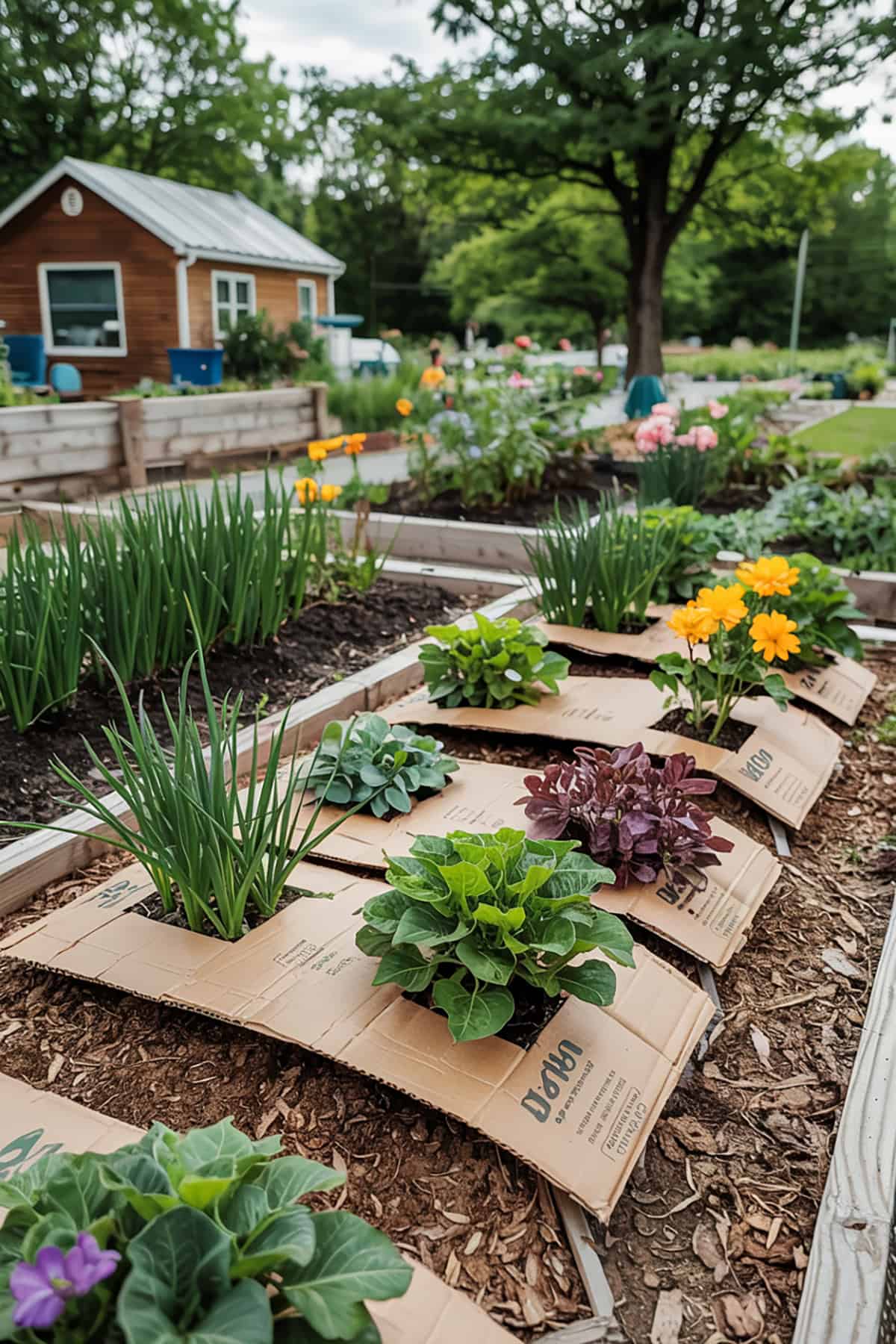
Starting a new bed? Lay down cardboard over the grass or weeds, overlapping the edges. Mow or cut the grass low first.
Wet the cardboard, cover with soil or mulch, and cut holes to plant through. The cardboard smothers weeds and eventually turns into compost. It’s an easy way to skip digging.
Reclaimed Wood Garden Sign
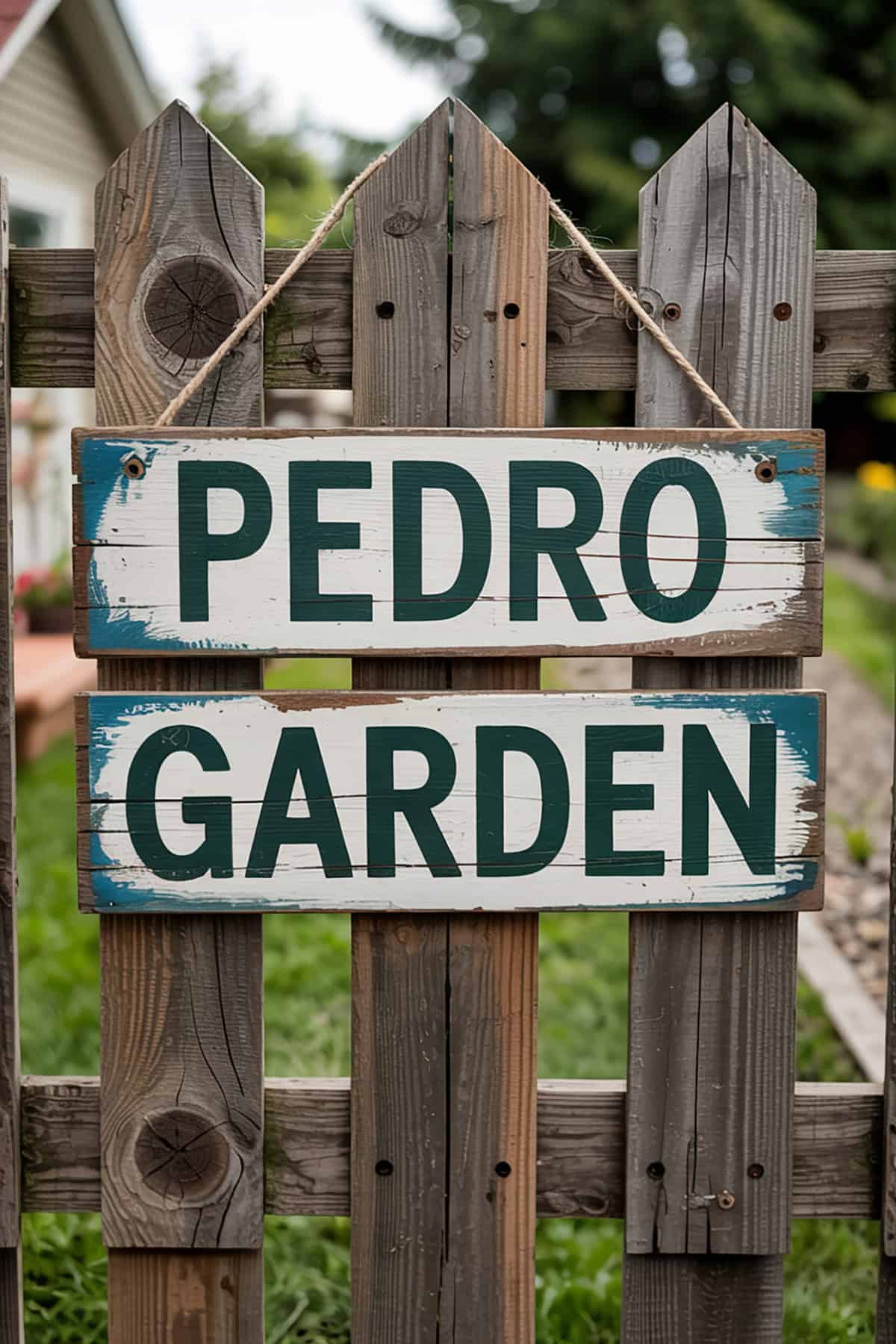
Old wood scraps make great garden signs or markers. Sand down the edges, paint or stencil on names or designs, and seal with varnish for weather protection.
Mount them on posts or fences. They add a bit of personality and help people (and you) remember what’s planted where. Plus, it’s a nice way to use up scrap wood.
Vintage Chair Planter

Broken chairs don’t have to go to the dump. Take out the seat, leaving the frame, and drop in a pot or basket.
Paint or decorate the chair however you like. Set it along a path or in a shady spot. It’s quirky, cheap, and keeps old furniture out of the landfill.
Plastic Kiddie Pool Garden Bed
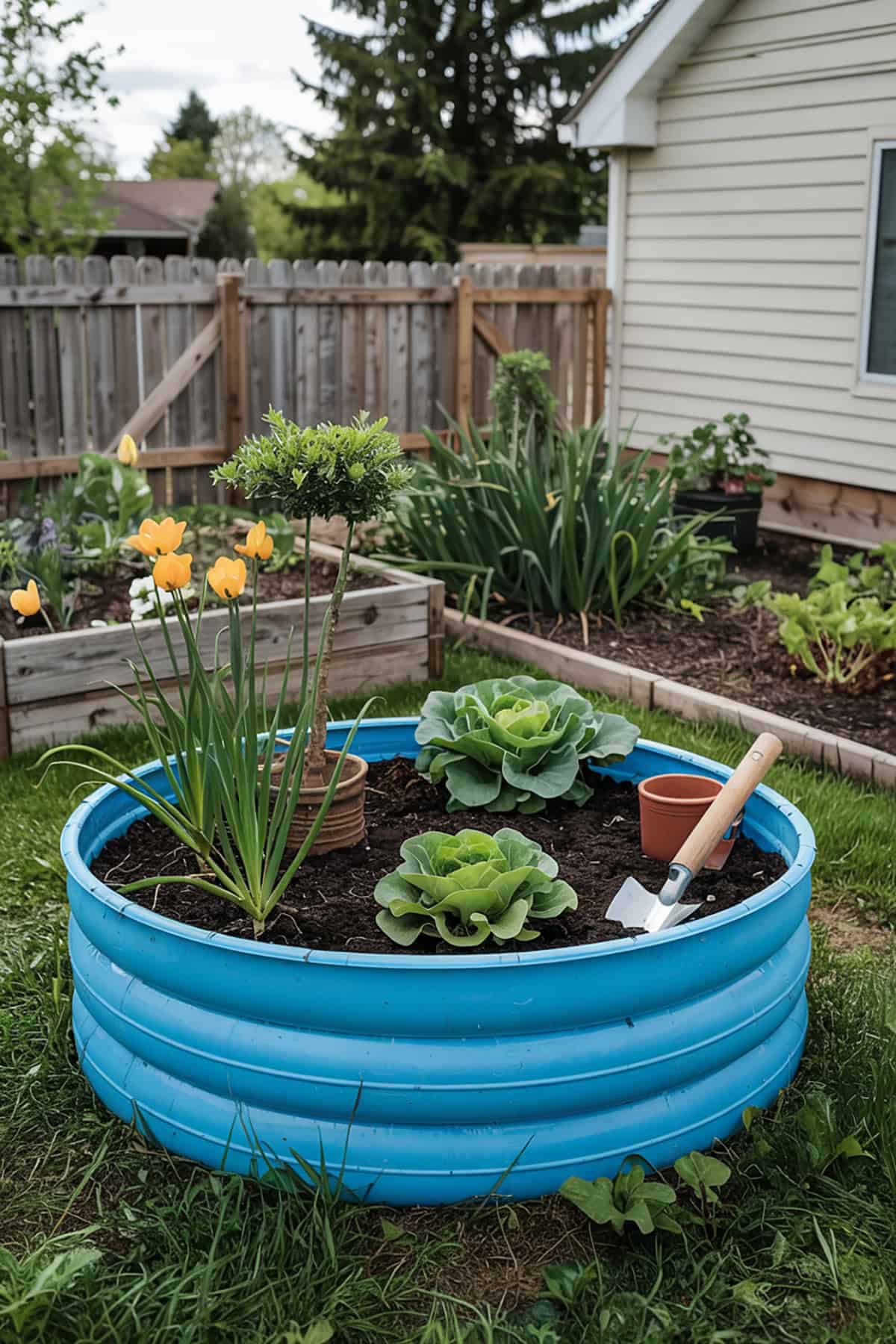
Kiddie pools make instant garden beds. Poke drainage holes in the bottom, set the pool in a sunny spot, and fill with potting mix or compost.
Grow veggies, flowers, whatever you like. They’re easy to move and lift, and you can usually find them cheap at yard sales in spring.
Painted Stones As Garden Markers

Flat stones are perfect for marking plants. Clean them off and paint the names of herbs or veggies with waterproof paint or a marker.
Stick them at the start of each row or next to your plants. They’re fun for kids to make, and they stand up to the weather.
Simple DIY Trellis With Bamboo Or Sticks
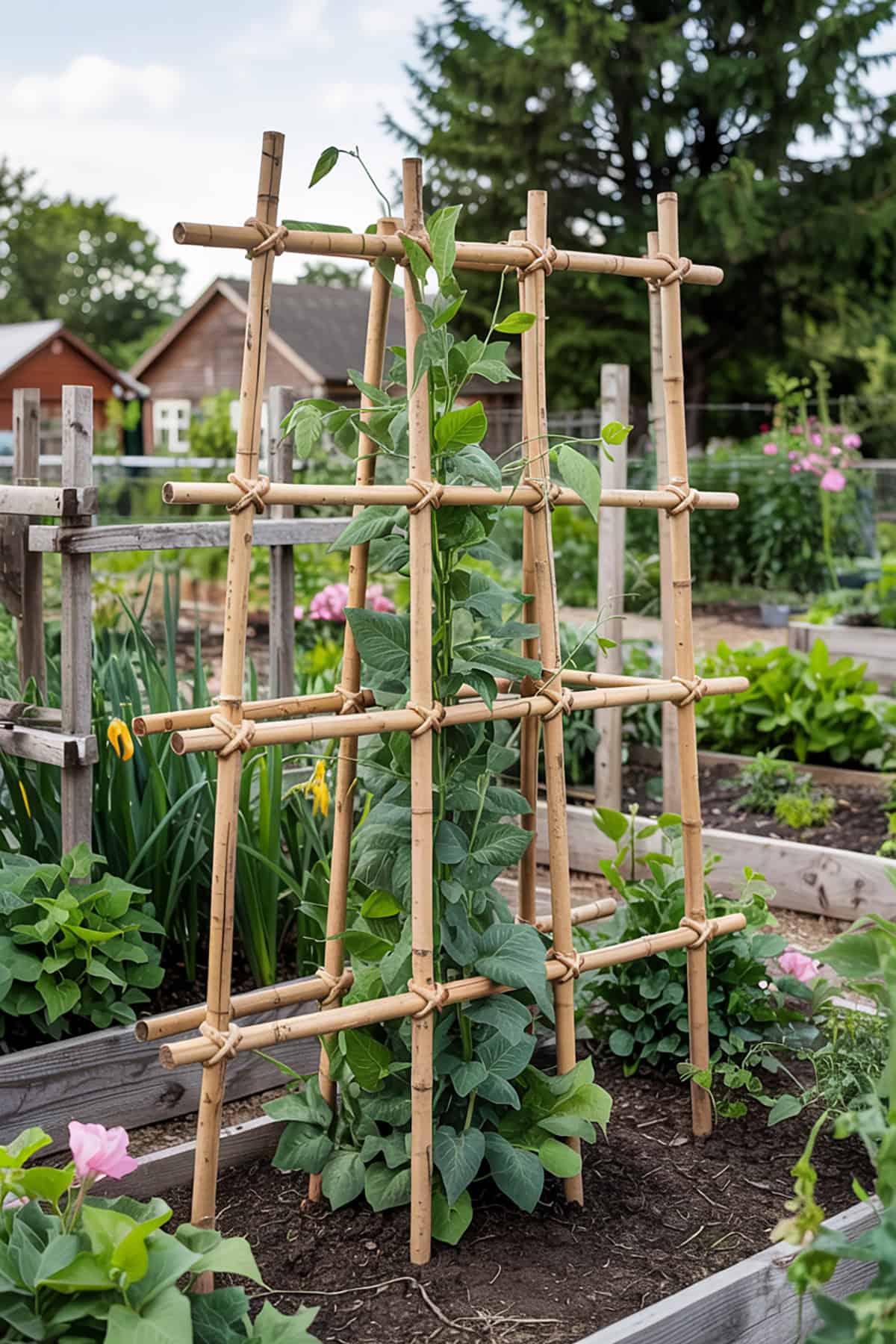
Climbing plants need support. Tie bamboo poles or sturdy sticks together at the top with twine or zip ties.
Anchor the trellis in your bed or pot, then train the plants up as they grow. These natural trellises blend in and are way cheaper than metal ones.
Reused Wine Bottles As Edging

Wine bottles make surprisingly good garden edging. Peel off the labels, wash them out, and bury the necks upside-down along your beds.
The glass catches the light and marks the edge between grass and soil. They don’t rot and need no maintenance. Works best for small spots, especially when the sun hits just right.
DIY Fire Pit With Concrete Blocks
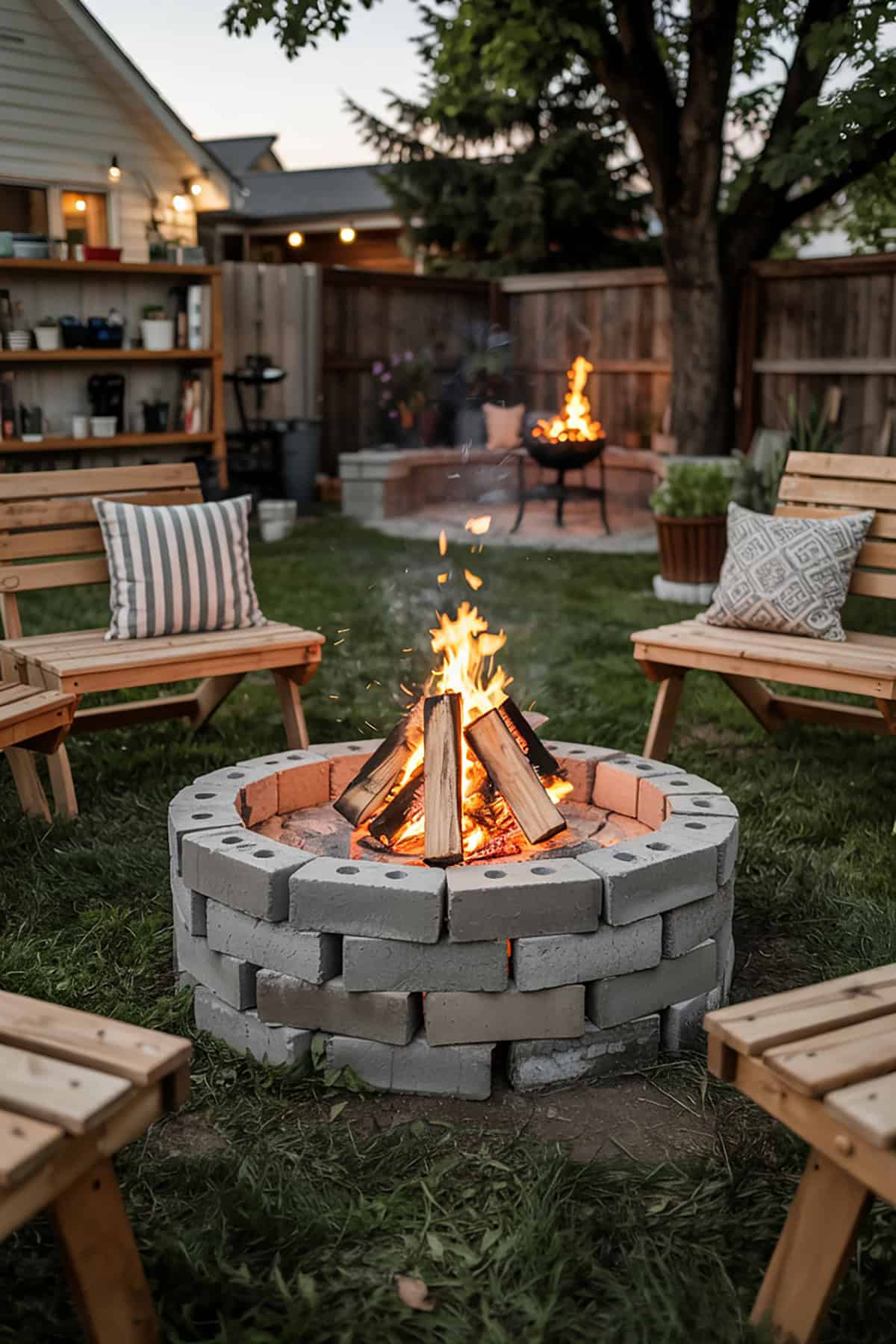
Want a fire pit? Stack concrete blocks in a circle, two or three high, leaving a few gaps for air flow.
Clear the grass first, then line the inside with gravel or sand for safety. These pits last through several seasons and cost way less than fancy kits. You can put one together in under an hour.
Hanging Mason Jar Lanterns

Mason jars make charming outdoor lanterns. Hang them from tree branches or hooks with wire or string, and drop in a candle or solar tea light.
Try hanging them at different heights for a cozy vibe. They set the scene for evening hangouts and use stuff you probably already have lying around.
PVC Pipe Garden Tool Holder
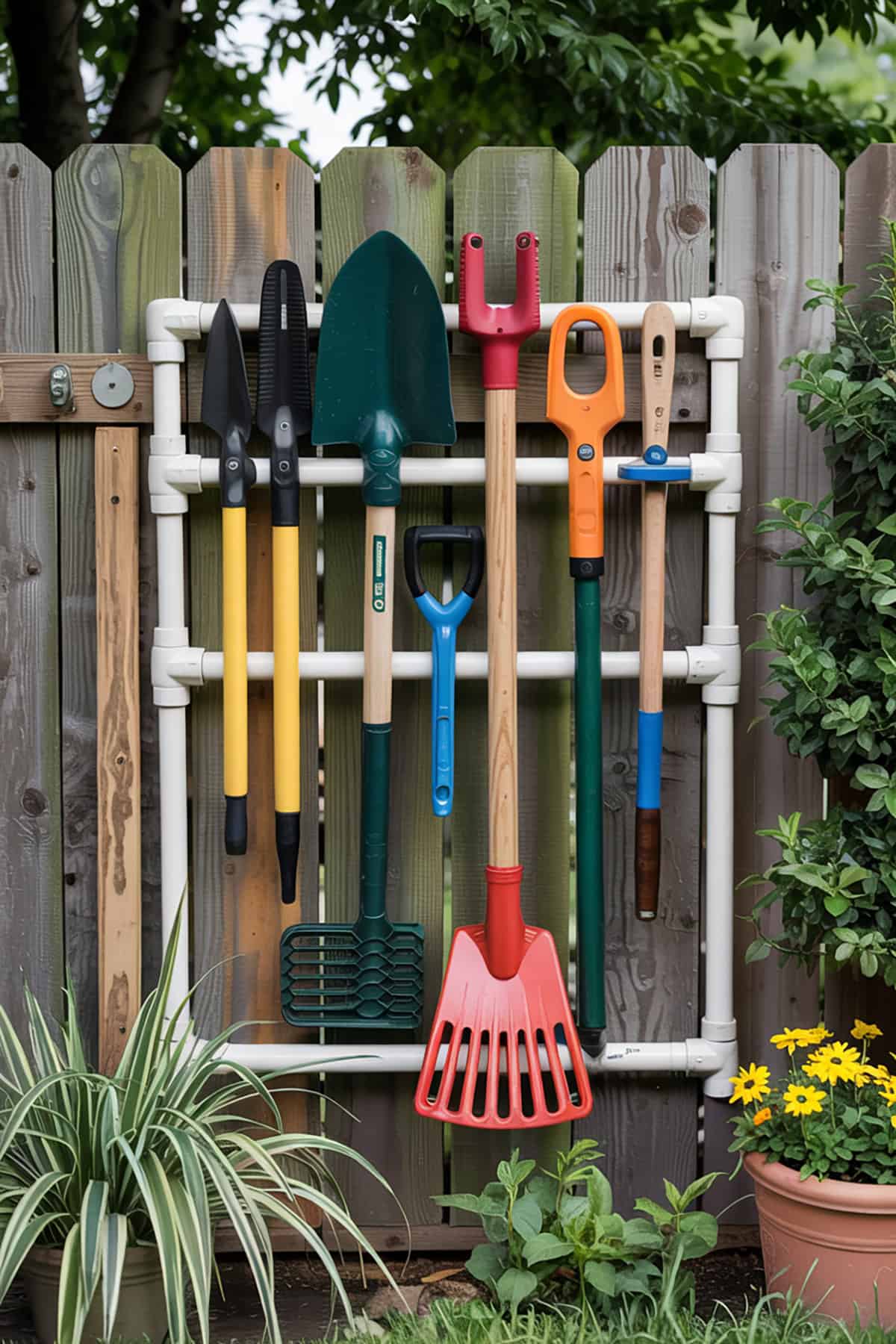
Keep shovels and rakes out of the way with PVC pipe. Cut it into lengths and mount vertically on your shed wall or fence. Slide tool handles in for easy grabs.
Label the slots if you want. PVC holds up to weather and keeps tools off the wet ground—no more tripping over them.
Thrifted Bench In Garden Nook

A bench is a simple way to create a resting spot. Hunt for one at thrift stores or garage sales, then clean or repaint it as needed.
Set it under a tree or behind a flower bed. Add a pillow or throw to make it inviting. It’s a nice way to use neglected corners of your yard.
DIY Compost Bin From Pallets
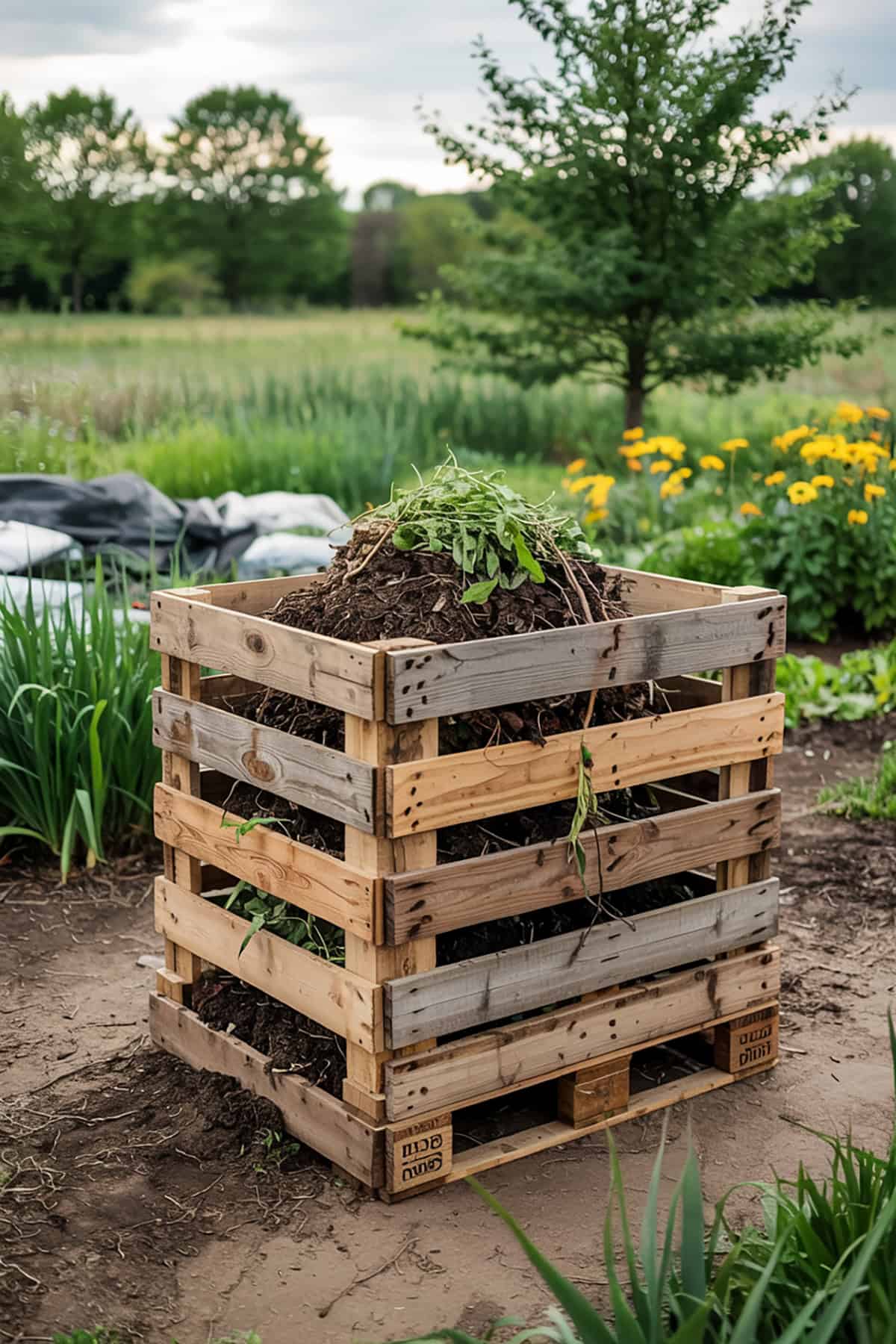
Pallets are perfect for a quick compost bin. Stand three up in a U-shape and connect them with nails, wire, or zip ties. Leave the front open for easy turning.
Layer in garden waste and kitchen scraps. Pallets let air in so things break down faster. You’ll have free compost for your beds before you know it.
Old Wheelbarrow Planter
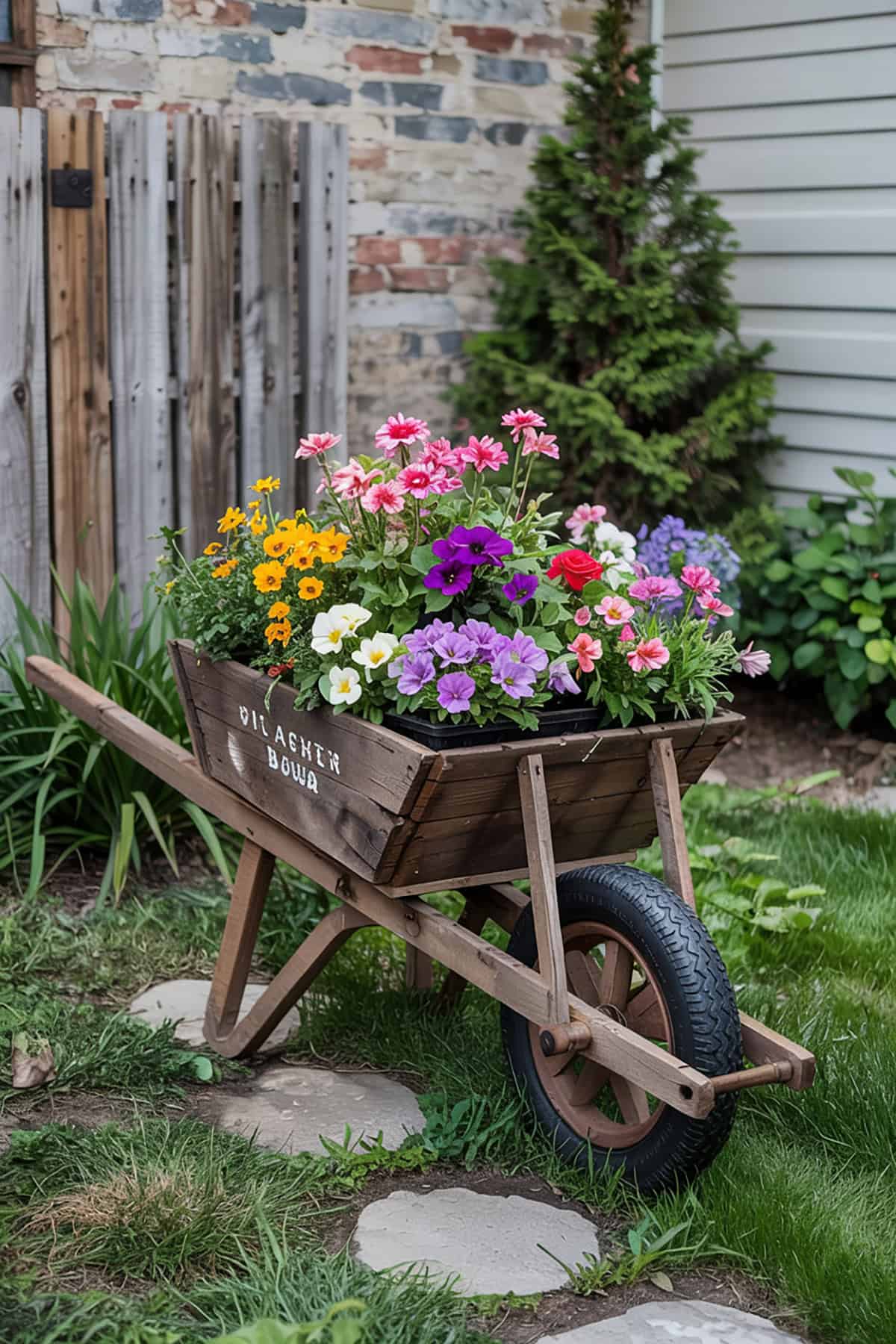
Got an old wheelbarrow lying around? They make surprisingly charming mobile planters. Just drill a few holes in the bottom for drainage, toss in some soil, and plant whatever you like—flowers, herbs, trailing vines, you name it.
Move it wherever you want a pop of color or a bit more sun. Metal or wood, either type works fine for this. There’s something satisfying about giving a cast-off tool a second life in your garden.
Rope-Wrapped Planter From Bucket
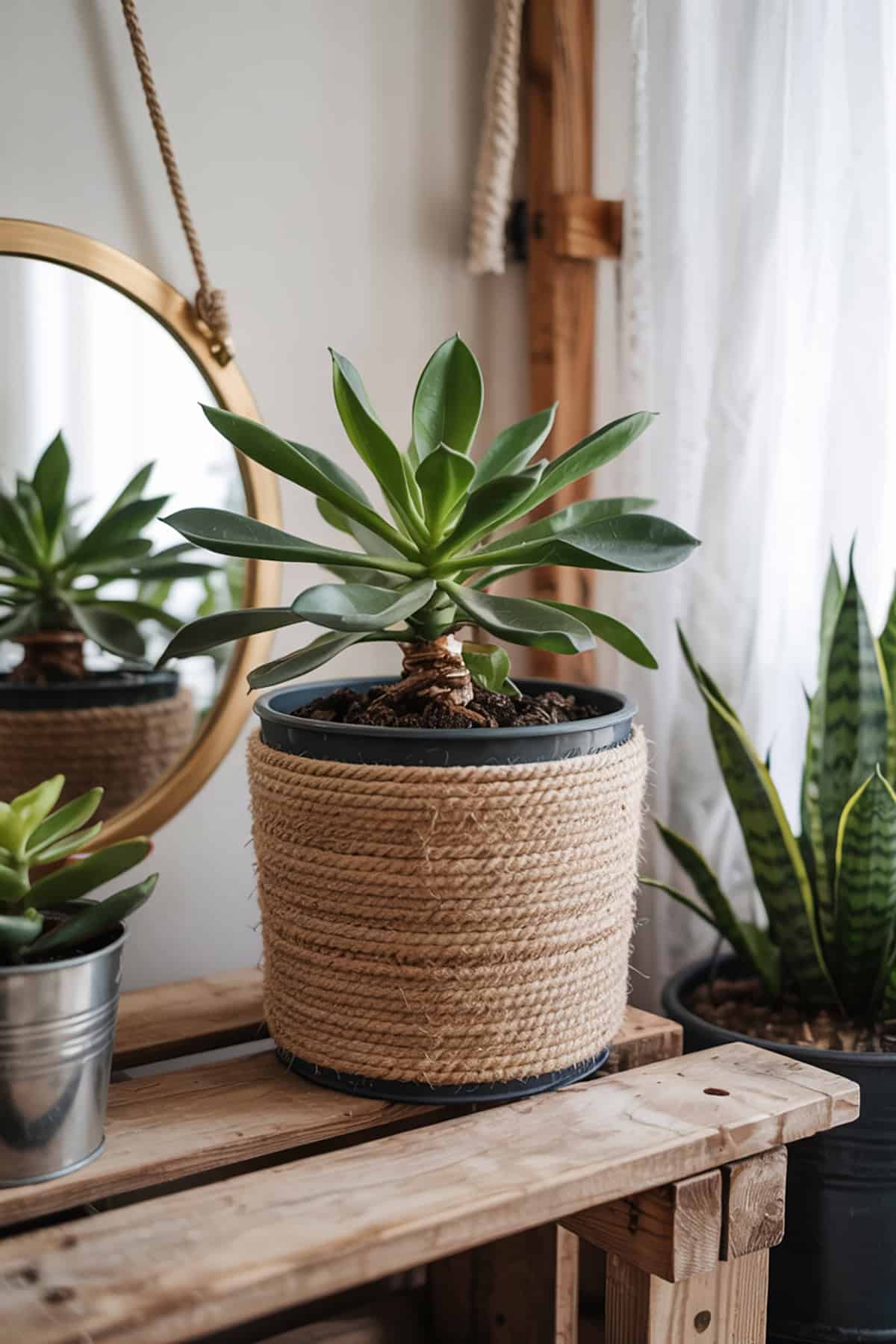
If you’ve got a spare bucket, it’s easy to turn it into a decorative planter. Wrap thick rope around the outside, gluing as you go, and tuck the ends inside for a tidier finish.
You can paint the rim if you’re feeling fancy or just leave it as is. Fill it up with soil and add your favorite flowers or even some veggies. It’s a simple way to hide the plastic and blend in with other natural touches in your yard.
Rain Gutter Planter Wall
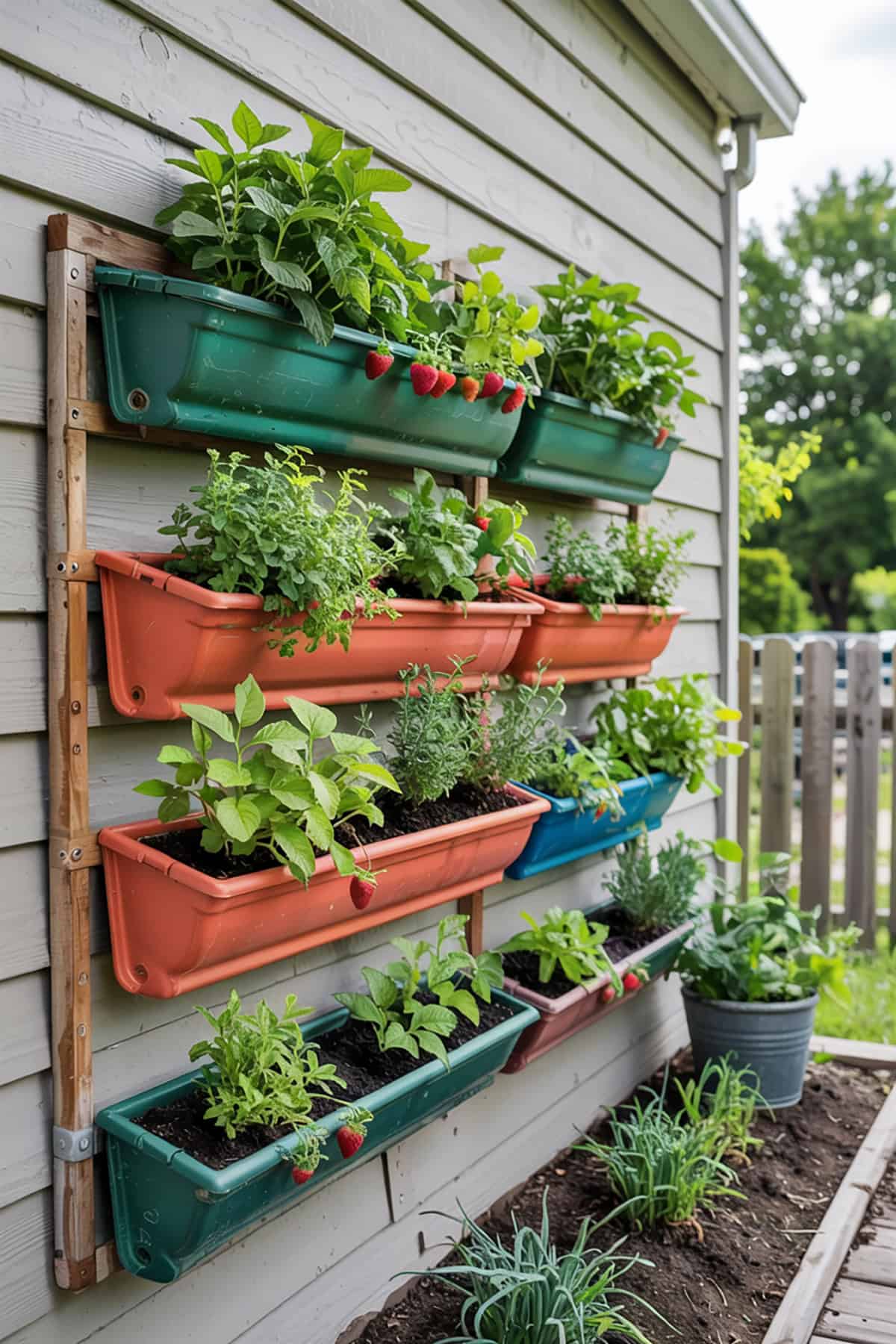
Salvaged rain gutters can be mounted on walls or fences as quirky horizontal planters. Just drill a few holes along the bottom for drainage, then attach the gutters in rows—make sure there’s enough space between them so sunlight actually gets through.
Toss in some potting soil and you’re good to go for shallow-rooted plants like lettuce, spinach, or even strawberries. Keep the soil moist (which honestly means watering more often than you’d think). Gutter planters are a clever way to squeeze in extra growing space where ground beds just aren’t an option, plus you get to repurpose old materials instead of tossing them.
